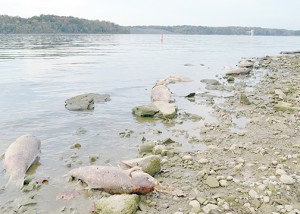

Editor
Visitors to Harsha Lake in East Fork State Park recently may be surprised by a large number of dead fish on the shores of the lake.
The fish died during a process called “turnover,” which is not typical, but is a naturally occurring process, said Debra Walters, fish management supervisor for the Division of Wildlife District 5 Southwest Ohio.
“Conditions were just perfect, unfortunately, for a fish kill,” Walters said.
The fish died because of low oxygen levels in the lake. The low levels were caused by strong winds, cloudy overcast conditions and the inflow of cooler water making the shallower water mix with the deeper, oxygen-deficient water, Walters said in an email.
In addition, dying and dead plants use oxygen, and when Walters and her team were on the lake on Sept. 28, Walters noticed the water was a tea-stained color rather than the typical green casted color.
When the U.S. Army Corp of Engineers took a dissolved oxygen profile on Sept. 27, they found that the oxygen level on the surface was 2.9 milligrams per liter. Fish need 4 mg./l or greater or the fish will start showing signs of stress that could kill them, Walters said.
On Sept. 28, Walters and her team also took an oxygen profile and found that the oxygen levels were not too bad in the first few feet but dropped drastically beyond that to less than 2 mg./l, indicating to Walters that turnover would occur soon.
In addition, Walters checked the water temperature on Sept. 29 and found it only varied by tenths of a degree, which is also an indication of turnover, she said in an email.
By Oct. 2, there were dead fish. Walters and her team could not have stopped the turnover because of the large size of the lake.
The gizzard shad, crappie, buffalo carpsucker and some larger hybrid striped bass were the primary species that died, Walters said.
The U.S. Army Corp took an oxygen profile again on Oct. 11 and found that the levels were a little over 4 mg./l on the surface, but were 3.95 mg./l at five feet and 2.56 mg./l at 10 feet. The levels are slowly coming back, Walters said in an email.
Walters said there are no plans for dead fish removal.
“We’ll let Mother Nature clean up the fish,” she said.
